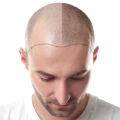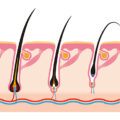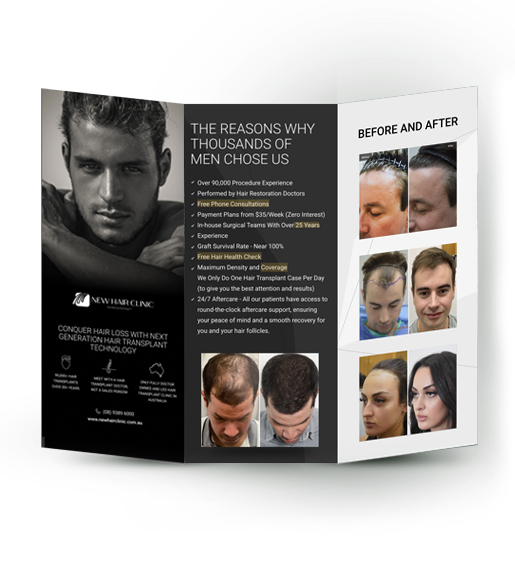Last updated on August 8, 2024
While it’s often associated with men, hair loss can be just as common for women, and can have a significant impact on your self-perception. In fact, Hair loss affects nearly 40% of women by the age of 50. Understanding the underlying causes is crucial for seeking appropriate treatment and managing hair loss effectively. This article from New Hair Clinic in Perth explores the various factors that contribute to hair loss in women. We’ll look at the biology of hair growth, identify the most common causes, and discuss the different ways hair loss can manifest.
The Hair Growth Cycle: Understanding the Roots of the Problem
Hair follicles on the scalp go through a natural cycle with distinct phases:
-
Anagen
This is the active growth phase, lasting 2-7 years for scalp hair. During this time, the hair follicle actively produces a new hair strand.
-
Catagen
The transitional phase, lasting a few weeks, signifies the end of active growth. The hair follicle begins to shrink and detach from the blood supply.
-
Telogen
This is the resting phase, lasting about 3 months, where the hair strand remains attached but is no longer actively growing. Eventually, the hair sheds to make way for a new one to begin the cycle again.
Hair loss occurs when the hair growth cycle is disrupted, leading to excessive shedding or a shortened growth phase. Let’s explore the common culprits behind this disruption.
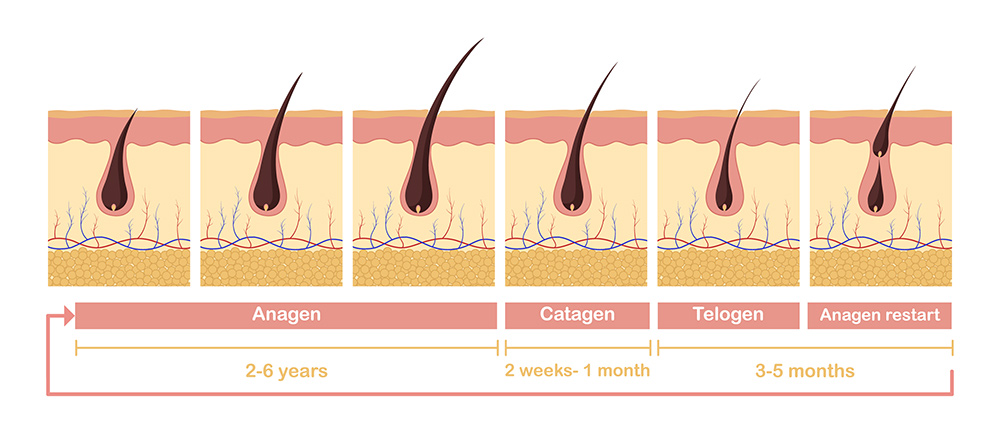
Hair loss is caused by a disruption of the natural hair growing cycle, which can cause excessive hair shedding temporarily or permanently.
Unveiling the Causes of Hair Loss in Women
Several factors can contribute to hair loss in women:
-
Genetics (Androgenetic Alopecia)
This is the most common cause of hair loss in both men and women. It’s influenced by genetics and sensitivity to dihydrotestosterone (DHT), a hormone derived from testosterone. DHT can miniaturised hair follicles over time, leading to gradual thinning on the scalp, particularly at the crown or hairline.
-
Hormonal Fluctuations
Changes in hormone levels throughout a woman’s life can significantly impact hair growth. Pregnancy, childbirth, menopause, and polycystic ovary syndrome (PCOS) are all associated with temporary or permanent hair loss. During these times, hormonal imbalances can disrupt the hair growth cycle, leading to increased shedding or thinning hair.
-
Stress
Chronic stress can have a detrimental effect on hair health. The body’s response to stress can push hair follicles prematurely into the resting phase, resulting in noticeable hair loss.
-
Medical Conditions
Certain medical conditions and their related treatments can contribute to hair loss. These include thyroid disorders, iron deficiency anaemia, autoimmune diseases like alopecia areata, and medications like chemotherapy or certain blood thinners.
-
Scalp Health Issues
Inflammatory scalp conditions like seborrheic dermatitis or scalp psoriasis can trigger a type of hair loss by creating an unhealthy environment for hair follicles. Fungal infections or scarring on the scalp can also cause localised hair loss.
-
Lifestyle Factors
Poor nutrition with deficiencies in essential vitamins and minerals like iron, zinc, and biotin can negatively impact hair growth. Additionally, certain hairstyles that put excessive tension on the scalp (tight braids, ponytails) can lead to a type of hair loss called traction alopecia.
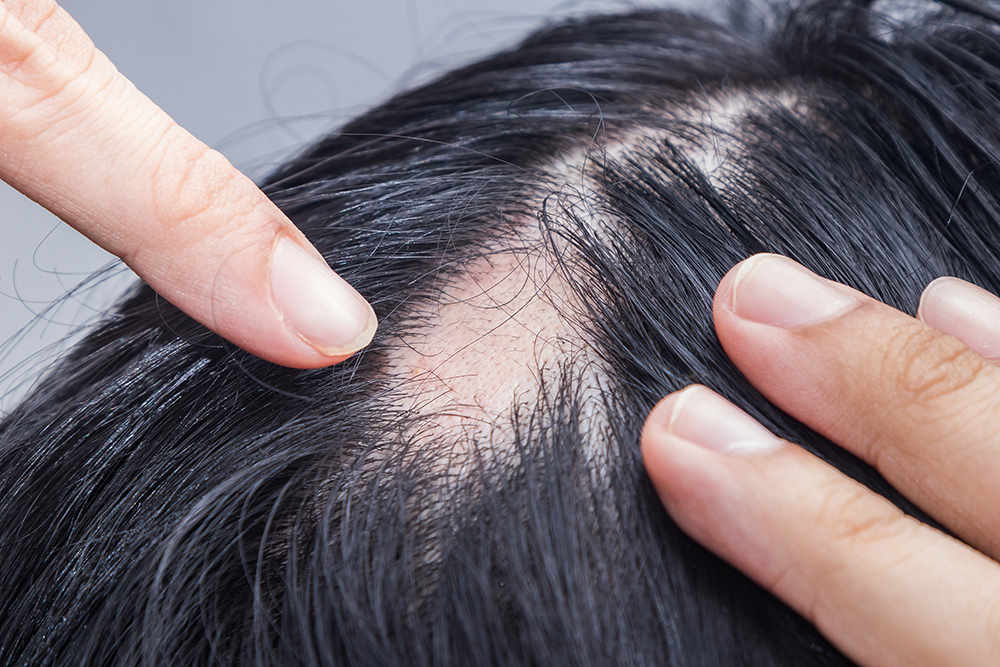
Stress, certain medications and medical conditions, and even genetics can cause hair loss in women. It is important to talk to your doctor and know the underlying cause before treating hair loss.
Recognising Hair Loss Patterns in Women
Hair loss in women can manifest differently than in men. Here are some common types of hair loss:
-
Diffuse Thinning Hair
This is the most common pattern characterised by overall hair loss across the entire scalp, leading to a reduction in hair density. It is a sign of hereditary female pattern hair loss.
-
Frontal Fibrosing Alopecia
This type of hair loss affects the frontal hairline and temples, causing a receding hairline similar to male pattern baldness. However, it’s less severe and doesn’t typically progress to complete baldness.
-
Patchy Hair Loss (Alopecia Areata)
This autoimmune condition causes circular or oval patches of hair loss anywhere on the scalp or body.
It’s important to note that these patterns can vary depending on the underlying cause. If you’re experiencing hair loss, consulting a hair loss doctor can help identify the causes of hair loss and determine the most effective treatment plan.
How to Treat Hair Loss
Hair loss can be emotionally challenging and may significantly impact a woman’s self-esteem. Thankfully, there are various hair loss treatment options available to manage and potentially reverse hair loss in women. These can include:
-
Hair Loss Medications
Minoxidil, a topical solution, is a common first-line treatment for female pattern hair loss. Certain medications, like finasteride, may be used in specific cases based on a doctor’s evaluation.
-
Platelet-Rich Plasma (PRP) Therapy
This innovative treatment utilises injections of a patient’s own concentrated platelets to stimulate hair growth.
-
Hair Transplant Surgery
For women with advanced hair loss or female pattern baldness and suitable scalp laxity, hair transplant surgery offers a permanent solution. Follicular Unit Extraction (FUE) is a minimally invasive technique that involves transplanting healthy hair follicles from the donor area (back of the scalp) to the balding areas. At New Hair Clinic in Perth, we use an advanced FUE method called Precise Follicle Implantation (PFI) for the most effective results.
Consulting a qualified hair loss doctor is crucial for exploring the best treatment options for your specific case.
It’s Time for Healthy, Fuller Hair with New Hair Clinic in Perth
Hair loss in women is a prevalent concern with various contributing factors. Understanding the underlying causes through a professional evaluation is crucial for finding the right treatment approach. Here at New Hair Clinic in Perth, we offer a comprehensive range of hair loss solutions, including free consultations, to help women regain control of their hair health and achieve a fuller, healthier head of hair.
Schedule a free consultation with our experienced hair loss doctors today and explore your personalised path to healthier hair!
FAQs
Is hair loss in women permanent?
Hair loss can be temporary or permanent depending on the underlying cause. Early intervention is key for addressing hair loss and promoting regrowth. Book a free evaluation from our experienced hair loss team today to discuss the best way to treat hair loss.
What are some signs that I may be experiencing hair loss?
Excessive shedding (more than 100 hairs per day), noticeable thinning of the scalp, a receding hairline, or patchy hair loss are all potential signs of hair loss. It is also important to know if you have a family history of female pattern baldness (androgenetic alopecia – a genetic condition like male pattern baldness).
Can stress really cause hair loss?
Chronic stress can disrupt the hair growth cycle, leading to increased shedding or temporary hair loss. Managing stress levels and boosting your nutrient intake can be beneficial for overall hair health.
What vitamins and minerals are important for hair growth?
Iron, zinc, biotin, and vitamin D are all essential nutrients for healthy hair growth. Deficiencies in these vitamins can contribute to hair loss.
What hairstyles should I avoid if I’m experiencing hair loss?
Tight hairstyles like braids, ponytails, or cornrows that put excessive tension on the scalp can worsen hair loss and cause temporary hair loss. Choose looser styles and avoid tight hair accessories to prevent this type of hair loss.
Where can I get help for my type of hair loss?
If you’re experiencing female pattern hair loss or any other type of hair loss, it’s advisable to consult a qualified hair loss doctor who can diagnose the underlying cause and recommend the most effective treatment plan.
Why choose New Hair Clinic in Perth for women’s hair loss treatments?
At New Hair Clinic Perth, our doctor-led consultations and procedures ensure you receive personalised care from hair restoration experts. We utilise the latest, most effective treatments and prioritise patient safety and outcomes. Contact us today for a free consultation.




